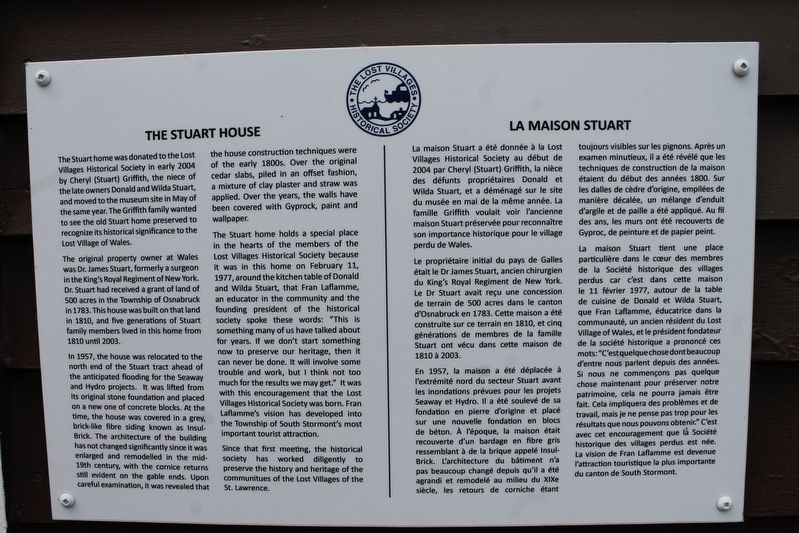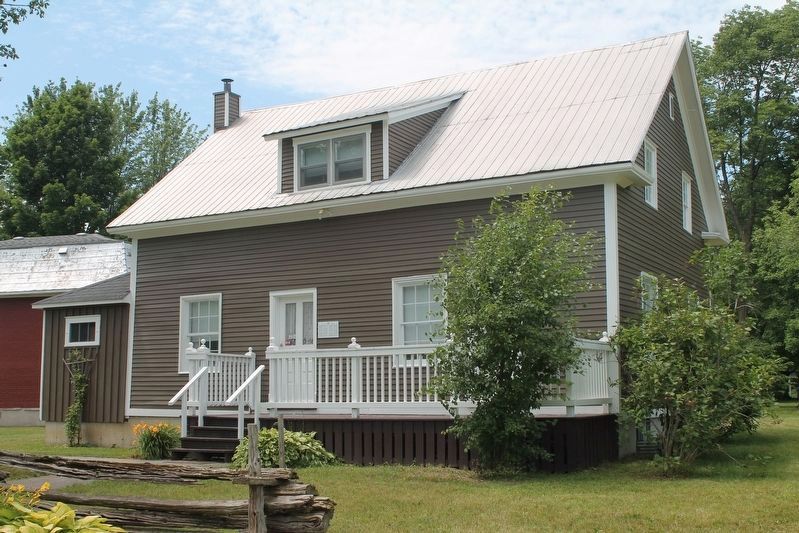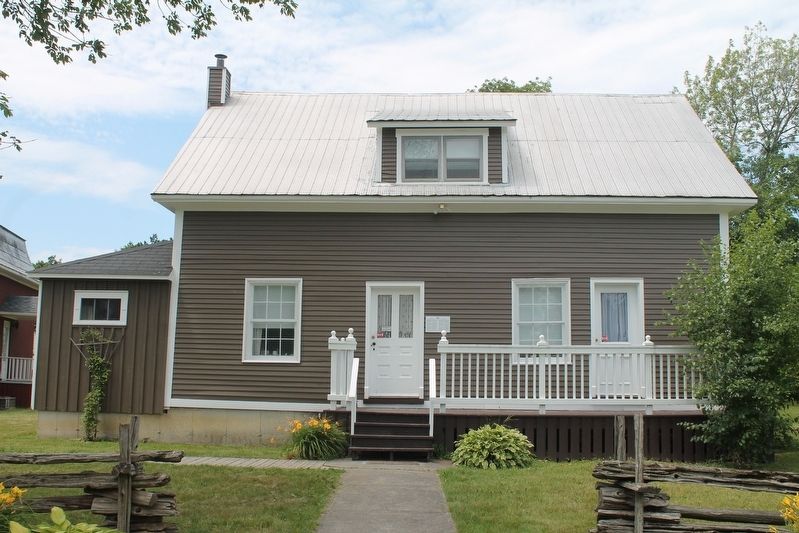Long Sault in Stormont, Dundas and Glengarry United Counties, Ontario — Central Canada (North America)
The Stuart House / La Maison Stuart
The original property owner at Wales was Dr. James Stuart, formerly a surgeon in the King's Royal Regiment of New York. Dr. Stuart had received a grant of land of 500 acres in the Township of Osnabruck in 1783. This house was built on that land in 1810, and five generations of Stuart family members lived in this home from 1810 until 2003.
The house construction techniques were of the early 1800s. Over the original cedar slabs, piled in an offset fashion, a mixture of clay plaster and straw was applied. Over the years, the walls have been covered with Gyprock, paint and wallpaper.
In 1957, the house was relocated to the north end of the Stuart tract ahead of the anticipated flooding for the Seaway and Hydro projects. It was lifted from its original stone foundation and placed on a new one of concrete blocks. At the time, the house was covered in a grey, brick-like fibre siding known as Insul- Brick. The architecture of the building has not changed significantly since it was enlarged and remodelled in the mid- 19th century, with the cornice returns still evident on the gable ends. Upon careful examination, it was revealed that The Stuart home holds a special place in the hearts of the members of the Lost Villages Historical Society because it was in this home on February 11, 1977, around the kitchen table of Donald and Wilda Stuart, that Fran Laflamme, an educator in the community and the founding president of the historical society spoke these words: "This is something many of us have talked about for years. If we don't start something now to preserve our heritage, then it can never be done. It will involve some trouble and work, but I think not too much for the results we may get.” It was with this encouragement that the Lost Villages Historical Society was born. Fran Laflamme's vision has developed into the Township of South Stormont's most important tourist attraction.
Since that first meeting, the historical society has worked diligently to preserve the history and heritage of the communitues of the Lost Villages of the St. Lawrence.
Le propriétaire initial du pays de Galles était le Dr James Stuart, ancien chirurgien du King's Royal Regiment de New York. Le Dr Stuart avait reçu une concession de terrain de 500 acres dans le canton d'Osnabruck en 1783. Cette maison a été construite sur ce terrain en 1810, et cinq générations de membres de la famille Stuart ont vécu dans cette maison de 1810 à 2003.
En 1957, la maison a été déplacée à l'extrémité nord du secteur Stuart avant les inondations prévues pour les projets Seaway et Hydro. Il a été soulevé de sa fondation en pierre d'origine et placé sur une nouvelle fondation en blocs de béton. À l'époque, la maison était recouverte d'un bardage en fibre gris ressemblant à de la brique appelé Insul-Brick. L'architecture du bâtiment n'a pas beaucoup changé depuis qu'il a été agrandi et remodelé au milieu du XIXe siècle, les retours de corniche étant toujours visibles sur les pignons. Après un examen minutieux, il a été révélé que les techniques de construction de la maison étaient du début des années 1800. Sur les dalles de cèdre d'origine, empilées de manière décalée, un mélange d'enduit d'argile et de paille a été appliqué. Au fil des ans, les murs ont été recouverts de Gyproc, de peinture et de papier peint.
La maison Stuart tient une place particulière dans le coeur des membres de la Société historique des villages perdus car c'est dans cette maison le 11 février 1977, autour de la table de cuisine de Donald et Wilda Stuart, que Fran Laflamme, éducatrice dans la communauté, un ancien résident du Lost Village of Wales, et le président fondateur de la société historique a prononcé ces mots: "C'est quelque chose dont beaucoup d'entre nous parlent depuis des années. Si nous ne commençons pas quelque chose maintenant pour préserver notre patrimoine, cela ne pourra jamais être fait. Cela impliquera des problèmes et de travail, mais je ne pense pas trop pour les résultats que nous pouvons obtenir." C'est avec cet encouragement que là Société historique des villages perdus est née. La vision de Fran Laflamme est devenue l'attraction touristique la plus importante du canton de South Stormont.
Erected by The Lost Villages Historical Society.
Topics. This historical marker is listed in these topic lists: Architecture • Settlements & Settlers.
Location. 45° 1.98′ N, 74° 51.021′ W. Marker is in Long Sault, Ontario, in Stormont, Dundas and Glengarry United Counties. Marker is on Fran LaFlamme Drive (Ault Park Road), on the right when traveling west. Touch for map. Marker is in this post office area: Long Sault ON K0C 1P0, Canada. Touch for directions.
Other nearby markers. At least 8 other markers are within walking distance of this marker. Forbes Memorial Reading Room / Salle de Lecture Commémorative Forbes (within shouting distance of this marker); Sandtown Advent Christian Church (within shouting distance of this marker); S.S. #17 - Roxborough Township School / S.S. #17 - L'Ecole du Canton de Roxborough (about 90 meters away, measured in a direct line); MacLeod Log House / Maison en Bois MacLeod (about 120 meters away); Lost Villages of the St Lawrence (about 120 meters away); Manson / LaPierre General Store (about 150 meters away); Corn Crib (about 150 meters away); Zina Hill Barber Shop / Le Salon de Barbier de Zina Hill (about 150 meters away). Touch for a list and map of all markers in Long Sault.
Regarding The Stuart House / La Maison Stuart. This building is part of the Lost Villages Museum
Credits. This page was last revised on July 29, 2022. It was originally submitted on July 20, 2022, by Robert Rusaw of Massena, New York. This page has been viewed 61 times since then and 10 times this year. Photos: 1, 2, 3. submitted on July 20, 2022, by Robert Rusaw of Massena, New York. • Andrew Ruppenstein was the editor who published this page.


